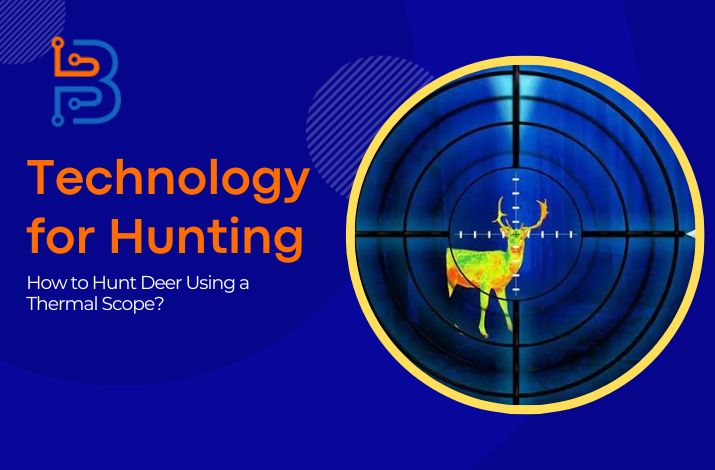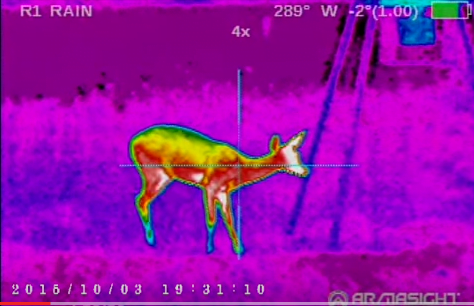Technology for Hunting- How to Hunt Deer Using a Thermal Scope?

Thermal scope technology has been around for a while in the ammunition industry, and it has some incredible uses for hunting too. Deer hunters often use thermal scope sights on their rifles to get assistance in the detection of animals in complete darkness. Still, there are some restrictions on using this technology for deer hunting, and most of the hunters are not familiar with how to use it.
Thermal scope sights are good for hunting in complete darkness or partial darkness. To hunt deer using a thermal scope sight, it is best to hunt using this scope half an hour before sunrise or half an hour after sunset. These are the durations when the bright sunlight does not conflict with the thermal scope. Hence, you can see thoroughly the deer population and location in dark and dense forests.
But before you go on using these sights on your rifle for deer hunting, it is vital to note that there are some restrictions to using it by law. Therefore, we have written this guide on how to hunt deer using a thermal scope to give you better insights into the technology for hunting.
Why Can’t You Hunt Deer Using a Thermal Scope?
The main reason why it is prohibited to do deer hunting with thermal scope technology is because of the rays emitted by the NVDs. Night Vision Devices can blind the deer, especially during the night time which causes stress and possible loss of vision for animals. The Wildlife Enforcement Authorities are strictly against such action, and for the safety of animals, they prohibit the use of thermal scopes for deer hunting.
Thermal imaging is a powerful tool for detecting thermal radiation, allowing hunters to see animals even in dark or overgrown areas. However, there are restrictions on thermal imaging cameras during deer hunting, which are determined to preserve populations and balance the use of natural resources.
First, it is essential to consider the laws of your country or region where you plan to hunt. In some jurisdictions, using thermal imaging cameras while hunting deer may be prohibited or restricted by certain conditions. This may relate to specific times of the year, population limits, or types of deer.
When is it Okay to Use a Thermal Scope to Hunt Deer?
It is important to note that the rules for using a thermal imager when hunting deer may differ in different regions and countries. Legislation may limit or regulate the use of this technology to conserve natural resources and ensure ethical hunting. Therefore, before hunting with a thermal imager, you must familiarize yourself with local laws and regulations.
In the region of United States, it’s illegal to use thermal scope for deer hunting in the states of Arizona, California, Indiana, Mississippi, Nevada, Colorado, Minnesota, Nebraska, Missouri, and Kansas. On the other hand, you may have to be licensed if you are using thermal scope for deer hunting in Illinois and Pennsylvania. Some of the states, like North Dakota, allow you to use night vision and thermal scope if it is not more than 6 volts.
Also, a thermal imager can hunt deer in hard-to-reach places like dense forests or thickets. Because thermal imagers, unlike other night vision devices, work with heat, allowing you to track an object’s movement even in scrubs. The technology will enable you to detect animals even in the most shaded areas, providing more opportunities for successful hunting.

Why Do You Need to Use a Thermal Scope?
Using a thermal imager for deer hunting can be justified for several reasons. First, the technology allows hunters to hunt at night when deer become more active and their movements less predictable. This increases the chances of a successful outcome and can help control deer populations while reducing potential impacts on vegetation and other species.
Secondly, thermal imaging technology lets you detect animals even in hard-to-reach places, such as dense forests or thickets. This helps to increase hunting efficiency and reduce the chance of false shots that can lead to the illegal killing of animals.
That is why this technology can be both a help for the hunter and accuracy and help in maintaining the number of populations and preventing accidental killing or wounding of animals.
What to Look for When Buying a Thermal Scope
Choosing a thermal imager is essential for those who want to improve their hunting or other activities in conditions of limited visibility. When purchasing a thermal imager, you should consider critical aspects ensuring maximum efficiency and satisfaction from using the technology.
Define Hunting Goals
First of all, you should define your needs and goals. Are you planning to use the thermal imager for hunting, night surveillance, military or professional tasks? The selection of the necessary characteristics and functions will depend on this.
Resolution and Zoom
Resolution is an important parameter. It determines the quality of the image and detailing of objects. The higher resolution lets you see details more clearly, which is especially useful when hunting long distances.
Vision Sensitivity
The sensitivity of the thermal imager to thermal radiation is also important. It determines how far and which objects can be detected. The higher the sensitivity, the more opportunities to see thermal traces.
Field of View
Working range and field of view are other vital features. They determine the maximum distance at which the object can be detected, as well as the width of the area that can be covered. Choosing a thermal imager with optimal parameters for your activity is essential.
Design Factor
Ergonomics and ease of use are also important factors. The thermal imager should be comfortable to hold and use for a long time. Compactness, weight, and type of fastening can affect the comfort of use.
Equally important is the quality of the optical system and the possibility of installing additional accessories, such as smartphone adapters or video recording. Such functions expand the capabilities of the thermal imager and increase its use.
Read Also: Exploring the Potential of Decentralized Digital Ledgers Technology
Conclusion
Using thermal scopes for deer hunting can surely improve vision in dark environments and at night times. However, the majority of the states in the United States prohibit the use of night vision, infrared sights, and thermal scopes. Only some of the states allow light and laser technologies, including thermal scopes with limitations of hardware. Hopefully, this article was helpful for you to learn about the use of thermal scope for deer hunting.






